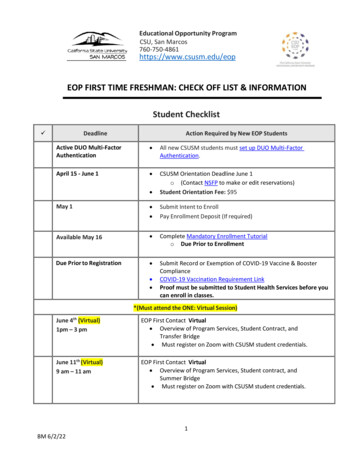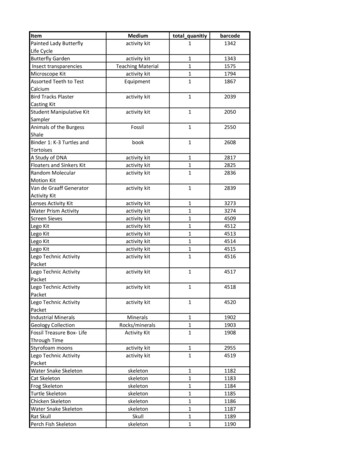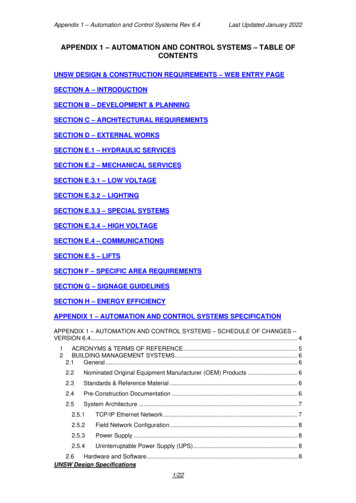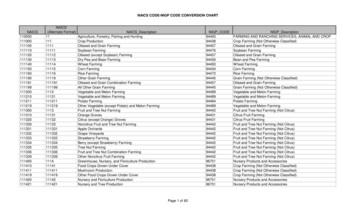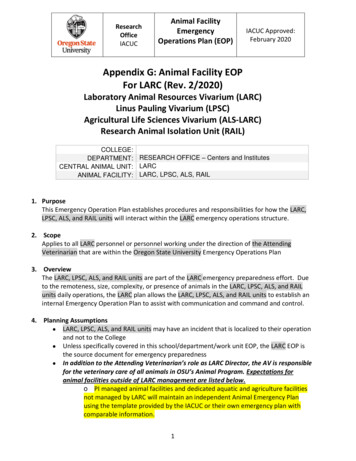
Transcription
ResearchOfficeIACUCAnimal FacilityEmergencyOperations Plan (EOP)IACUC Approved:February 2020Appendix G: Animal Facility EOPFor LARC (Rev. 2/2020)Laboratory Animal Resources Vivarium (LARC)Linus Pauling Vivarium (LPSC)Agricultural Life Sciences Vivarium (ALS-LARC)Research Animal Isolation Unit (RAIL)COLLEGE:DEPARTMENT: RESEARCH OFFICE – Centers and InstitutesCENTRAL ANIMAL UNIT: LARCANIMAL FACILITY: LARC, LPSC, ALS, RAIL1. PurposeThis Emergency Operation Plan establishes procedures and responsibilities for how the LARC,LPSC, ALS, and RAIL units will interact within the LARC emergency operations structure.2. ScopeApplies to all LARC personnel or personnel working under the direction of the AttendingVeterinarian that are within the Oregon State University Emergency Operations Plan3. OverviewThe LARC, LPSC, ALS, and RAIL units are part of the LARC emergency preparedness effort. Dueto the remoteness, size, complexity, or presence of animals in the LARC, LPSC, ALS, and RAILunits daily operations, the LARC plan allows the LARC, LPSC, ALS, and RAIL units to establish aninternal Emergency Operation Plan to assist with communication and command and control.4. Planning Assumptions LARC, LPSC, ALS, and RAIL units may have an incident that is localized to their operationand not to the College Unless specifically covered in this school/department/work unit EOP, the LARC EOP isthe source document for emergency preparedness In addition to the Attending Veterinarian’s role as LARC Director, the AV is responsiblefor the veterinary care of all animals in OSU’s Animal Program. Expectations foranimal facilities outside of LARC management are listed below.o PI managed animal facilities and dedicated aquatic and agriculture facilitiesnot managed by LARC will maintain an independent Animal Emergency Planusing the template provided by the IACUC or their own emergency plan withcomparable information.1
o Contact the AV or designee to assist with coordinating a response to facilityissues, procurement of back-power, evacuation, or animal illness or injury.o In the event of an emergency, facility personnel should be designated toattend to daily animal husbandry as deemed safe. If the facility is unsafe or afacility staff member is unavailable to attend to daily husbandry the AV shouldbe contacted to make alternate arrangements. If the AV cannot be reached,refer to the line of succession described in 7a below.o Distant sites will establish local veterinarian contacts and utilize them first inemergencies, with a follow-on call to the OSU Attending Veterinarian ordesignee.Sites outside the Corvallis area include:oHatfield Marine Science Center (HMSC) - NewportoOregon Hatchery Research Center (OHRC) - AlseaoEastern Oregon Agricultural Research Center (EOARC) - BurnsoEastern Oregon Agricultural Research Center (EOARC) - Union5. Concept of OperationsAn incident occurs that is within the capability or responsibility of the LARC, LPSC, ALS, and RAILunits. Through this plan, the LARC, LPSC, ALS, and RAIL units have identified a command andcontrol structure to plan for and respond to localized incidents. This plan is coordinated withthe LARC Emergency Operation Plan.The LARC Emergency Operations Plan provides guidance, direction, and emergencymanagement programmatic elements that this local EOP is designed to augment.As an incident occurs, individuals will respond to preserve their life safety and notify theAttending Veterinarian, or designee. Once activated the Attending Veterinarian, or designeewill initiate the Response Team to coordinate LARC, LPSC, ALS, and RAIL unit actions. Prioritiesfor personnel and animal response will be established and response activities commence asappropriate.Priorities during an emergency are: Personnel safety Animal safetyo Animals shelter in place - AND/OR o Animal evacuation and relocation Animal recapture Animal euthanasia (as authorized by the OSU Attending Veterinarian) Facility protection2
6. Organization and Assignment of ResponsibilitiesThe following structure and key personnel are responsible for the planning, preparedness, andimplementation of emergency management activities for the LARC, LPSC, ALS, and RAIL units.OversightThe Attending Veterinarian is responsible for the safety and protection of life, securingcritical infrastructure, and timely resumption of teaching, research, and business activities.Three (3) teams with designated responsibilities will carry out these activities.(1) Preparedness Team The Attending Veterinarian is responsible for making sure that plans, safety equipment,and infrastructure to deal with an emergency are in place. The Attending Veterinarian, or designee, will convene meetings/seminars and preparesummary materials to increase staff awareness of the content of this plan.(2) Response TeamThis team coordinates the emergency response for the LARC, LPSC, ALS, and RAIL units. TheResponse Team is comprised of the following members: Attending Veterinariano Organize the LARC, LPSC, ALS, and RAIL units response command and controlstructure.o Communicates with LARC Operation Centero Communicates with the OSU Dept. of Public Safety (541-737-3010)o Communicates with members of the Response Team.o Communicates with Research Office College Operation Centero Initiates communication to inform LARC, LPSC, ALS, and RAIL units personnel of aclosure or incident responseo Contacts building owners/representatives to respond to buildings For concerns related to buildings (HVAC malfunction, leaks, etc.) contactFacilities Serviceso Ensures all essential staff are on-siteo Will direct evacuation (via fire alarm pull station) if necessary LARC, LPSC, ALS, and RAIL units Technician supervisoro Contacts Attending Veterinarian (or designee)o Contacts Principal Investigator of affected animalso Initiates communication to inform LARC, LPSC, ALS, and RAIL units of a closure orincident responseo Oversees animal care needs as identifiedo Will direct evacuation if necessary Animal Husbandry Staffo Respond to animal care needs as identified3
LARC, LPSC, ALS, and RAIL units Executive Support Specialisto Notifies affected instructors, graduate and undergraduate students, intern programsand visiting colleges/universities of the current situation OSU Attending Veterinarian or designeeo Provides remote advice as needed OSU Attending Veterinarian or On-Call local Veterinarian (for distant units as describedin section 4)o Develop a network of veterinarian contacts if additional assistance is neededo Authorized to determine what additional assistance is needed(3) Recovery TeamThe purpose of this group is to restore teaching, research and business functions in a timelymanner. The Recovery Team is comprised of: Attending Veterinarian LARC, LPSC, ALS, and RAIL units Executive Support Specialist LARC, LPSC, ALS, and RAIL units Technician Supervisor7. Direction and Controla. Decision-making and Notification priorityWhen an incident occurs, each individual is responsible for the immediate life-safety response ofthemselves and personnel under their care. This could include such actions as calling 9-1-1,evacuating personnel and animals from the immediate area, activating the fire alarm, and(depending upon the level of training) providing first aid or extinguishing fires.The Attending Veterinarian, or designee, is responsible for approving resources orcommunicating assistance requests to the appropriate OSU Administration official or theCollege EOC (if activated).When an incident occurs, contact the Attending Veterinarian. If that person cannot bereached, the following line of succession is to be contacted (see Attachment 1 for namesand phone numbers):1) Alternate Attending Veterinarian2) LARC Office3) IACUC Administrator4
b. Call ListsLARC, LPSC, ALS, and RAIL units has/have developed call lists to assist with response.Attempt to contact the first person and if no response, continue down the list until aresponse is obtained:1) OSU Attending Veterinarian2) LARC Executive Support Specialist or Front Office3) Technician Supervisor Veterinarians1) OSU Attending Veterinarian2) Alternate Attending Veterinarian3) The OSU Veterinary Teaching Hospitalc. ControlThe Attending Veterinarian, or designee, is responsible for the coordination of responseresources to the incident. This Command Center location is the hub of information duringan emergency incident.The LARC, LPSC, ALS, and RAIL units will organize and coordinate the incident response fromthe following Command Center locations (in order of preference):1) LARC Building Conference room2) RAIL if the main campus is inaccessible8. CommunicationsSeveral avenues exist for communication to LARC, LPSC, ALS, and RAIL unit staff, faculty,students, and volunteers. Depending upon the extent/level of the situation, multiplecommunication paths may be used to ensure personnel are kept informed:5
(delete those that don’t apply to your unit)MethodAvail w/ power TelephoneX Cell phoneX E-mailX OSUAlert – if a universityXwide incident Local Bulletin BoardAvail w/o powerXXX (via mobile phone)X (via mobile phone)XAs a minimum, the information will be reviewed by the OSU Attending Veterinarian prior torelease for mass distribution.Computer access is limited to the office and laboratory areas; therefore, cell phones andradios are the primary modes of communication between personnel.Contact lists are reviewed twice a year (or after the arrival of new personnel) and posted atall available phones and procedures locations.9. Plan MaintenanceThe plan will be updated as necessary, based upon periodic reviews, improvement itemsidentified from drills or actual incident responses, and changes to the threat environment.Questions about this plan should be directed to the Attending Veterinarian.10. Plan Training and TestingA. Training New employees receive an orientation to this disaster plan and their response duties Annually, all employees receive a review of the plan and their roles during emergencies Employees receive periodic training of unit specific animal handling and responseproceduresB. Drills/Exercises Fan-Out Calling/Call Tree notifications are conducted periodically to test the accuracy ofphone numbers and communications Mock emergency drills should be conducted periodically to test all components of theemergency response plan After the drill or incident response, discussions regarding strengths and weaknesses ofthe plan and response are held and procedures updated, if necessary6
Attachment 1Emergency Contacts(Personal Information: Do not release or re-distribute, unless approved by the AttendingVeterinarian)Title/PositionBenton County SheriffBenton Public Health Dept.Corvallis PoliceCorvallis Fire DepartmentState PoliceOSU Dept. Public Safety (DPS)OSU Environmental, Health, andOccupational Safety (EH&S)OSU Attending VeterinarianOSU IACUC AdministratorLARC Command CenterRAIL ContactsLPSC ContactsFacilities -EmergencyNon-EmergencyNon-EmergencyWork PhoneCell 766-6961See OSU DPS belowEmergencyNon-Emergency Dispatch541-737-7000541-737-3010DPS Dispatch541-737-3010Dr. Jennifer SargentDr. Brianna Beechler(Alternate)Rob 5392Front office: 541-737-2263Break roomBreakroomBusiness hoursEmergency/After hours541-737-8556Breakroom: 1-737-3010OSU DPSLocal veterinarian (for distant facilities)541-867-0265Hatfield Marine Science CenterDr. Tim Miller-MorganDr. Masie Custis; Harney541-573-6450EOARC- BurnsCounty Veterinary ClinicDr. Terry McCoy541-963-6621EOARC- UnionAnimal Health Center(Personal Information: Do not release or re-distribute, unless approved by the AttendingVeterinarian)7
Attachment 2Emergency Response Supplies - PersonnelThis suggested supply list is for the emergency response team’s needs. These items should bekept accessible in areas that emergency responders may be working within. Supply distributionwill be coordinated by the Command Center.WaterFoodElectricalTransportationEquipment Drinking water-1 gallon per day/per person, keep 3 days supply onhand. Replace on a quarterly basis. Non-Perishable Food -in an airtight, pest-proof container. Replace on anannual basis or per expiration date Extra batteries for devices Fans Space heaters Extension Cords/ Plug adaptors LARC truck Personal vehicles Portable, bi-directional, radio transceivers (walkie-talkies) Flashlight/ Lanterns and extra batteries- keep extra flashlights in CC tosend out with personnel Transistor Radio (with batteries) Rope Tools needed to shut down equipment, gas tanks, etc Utility knife First Aid Kit - Identify any special needs per the Attending Veterinarian Blankets Light sticks Heavy-duty work gloves Copies of emergency plan Zip ties8
Attachment 3Emergency Response Supplies - enclosures)Equipment(handling)FuelRodents: HydroPac water pouches. At least 2 week supply maintained atall times. Gel packs are also kept in the vivaria and can be used fornutritional/hydration support if necessary.RAIL: Large troughs typically hold 1 weeks’ worth of water Maintain 2 weeks supply in storage LARC, LPSC, ALS, and RAIL have backup generators LARC truck (everything except livestock) VTH horse trailer for camelids Cages for rodents Crates for larger animals Leads and halters for camelids Tested and refueled by Facilities Services monthly9
Attachment 4Evacuation1. Follow general personnel evacuation preparedness, mitigation, response, and recovery as listedin the LARC EOP – Appendix F2. Evacuation procedures unique to LARC, LPSC, ALS, and RAIL units animal areas are:A. Personnel - evacuate to Command Center or alternate located at LARC or RAIL if access tothe main campus is limitedB. Animals - Once personnel is accounted for and the situation assessed, the LARC, LPSC, ALS,and RAIL units will work with the Attending Veterinarian or designee (in remote locations,this could be a local veterinarian) to determine what emergency response is needed for theanimals.LARC- small rodent housing facilityLPSC- rodent housing facilityALS- very small rodent and aquatics housing facilityRAIL- Pasture and large animal housingLARC, LPSC, ALS, and RAIL units planning for animal evacuation include:1) Evacuation Site SelectionNote: due to the risks associated with large scale animal movement for the animals’well-being and the ongoing research, sheltering in place is strongly preferred wheneverit is a safe and feasible option.a) Identification of evacuation sites. Pre-identified sites are: Animals may be moved from one LARC managed housing area to another(example, from ALS to LPSC) in an emergency. If off-campus housing of research animals is required there is Memorandum ofUnderstanding (MOU) with OHSU campuses and VA to provide assistance withemergency housing of research animals2) Public Health Concernsa) Consider the exposure of zoonotic diseases when identifying sites and transportroutes.b) Other hazards3) Animal Well-being10
a) Transit Will the animals be put in greater jeopardy while in transit?b) Temperature Can the micro- environment be controlled to keep the animal comfortable?c) Health Status Will the evacuation affect the health status of the animal so that the animal iscompromised, rendering them unsuitable for the intended research?d) Food and water11
Attachment 5Shelter in Place1. Follow general sheltering preparedness, mitigation, response, and recovery as listed in theLARC EOP – Appendix F2. Sheltering procedures unique to LARC, LPSC, ALS, and RAIL units are:A. Personnel - shelter in the following buildings (listed in priority of preference): LARC, RAIL If unable to reach a building, shelter in a closed vehicle and communicate your status tothe Command Center.B. Animals - Once personnel is accounted for and the situation assessed, the LARC, LPSC, ALS,and RAIL units will work with the Attending Veterinarian or designee (in remote locations,this could be a local veterinarian) to determine what emergency response is needed for theanimals.1) Shelter Site Selection Identification of shelter sites: Animal housing areas of LARC, LPSC, ALS, and RAIL2) Public Health Concerns Consider the exposure of zoonotic diseases when identifying sites and transportroutes. Other hazards3) Animal Well-beinga) Temperature Can the micro- environment be controlled to keep the animal comfortable?b) Health Status Will the health status of the animal be compromised rendering them unsuitablefor the intended research?c) Food and water12
Attachment 6Euthanasia ProgramIf animals cannot be protected or removed from dangerous conditions then they must beeuthanized. Whenever possible, consult the AV to confirm that options for protecting or relocatinganimals have been exhausted prior to euthanasia. Units should maintain species-appropriatemeans required for euthanasia on site and accessible should emergency euthanasia be required.LARC managed facilities:Rodents and poultry- inhalant overdose with carbon dioxide or isofluraneAquatics- Buffered MS-222 overdose or, for zebrafish, rapid chillingOther animal species- Injectable pentobarbital euthanasia solution is available at LARC andis considered appropriate for a wide range of species13
Attachment 7Temperature Extremes1. Personnel - Follow general evacuation preparedness, mitigation, response, and recovery aslisted in the LARC EOP – Appendix F2. Animals – For indoor housed animals temperature extremes are generally associated withutility or HVAC failure. For more information see Attachment 9. For outdoor animals,contact the OSU Attending Veterinarian if temperatures for un-acclimated animals arebelow 45oF or above 85oF.14
Attachment 8Animal Escapes1. Appropriate steps will be highly dependent on the location, species, and number of animalsinvolved. Contact the OSU Attending Veterinarian or, if the escaped animal(s) are inimmediate danger or pose a threat to public safety call the Department of Public Safety. Ifthe DPS is contacted the dispatcher will send a follow on call to the AV to provideassistance.15
Attachment 9Utility and HVAC Failure1. Contact Facility Services to service dysfunctional equipment. If the HVAC or utility, failuremay create extreme temperatures, inadequate ventilation or aeration, or other harmful conditionsto animals contact the OSU Attending Veterinarian.For rodent facilities with individually ventilated caging, a power failure can result in insufficientventilation if the airflow is disrupted for 8 hours. If this occurs cages need to be partially removedfrom their slot by about 2 inches to allow air to circulate.Too HotIf the outdoor temperature is above 80ºF, the air supply to the animal housing room can beshut down.Animal room doors may be propped open to increase cool air circulation.Portable air conditioning units should be set up in the hallways and fans utilized to movecooler air into the rooms.Too ColdUse portable heaters to increase room temperatures. Beware that the use of too manyheaters may overload the circuit.If extreme temperatures cannot be managed with the animals in place, animals may be evacuatedto an alternate facility in consultation with the Attending Veterinarian.16
for the veterinary care of all animals in OSU's Animal Program. Expectations for animal facilities outside of LARC management are listed below. o PI managed animal facilities and dedicated aquatic and agriculture facilities not managed by LARC will maintain an independent Animal Emergency Plan using the template provided by the IACUC or their own emergency plan with comparable information. 2 .

